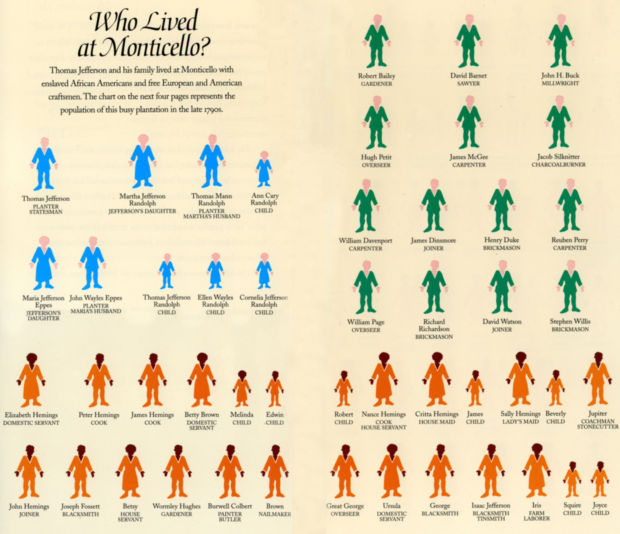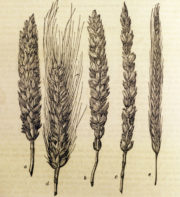Jefferson and Slavery
Reading Level: Elementary School
Jefferson’s Slaves
Over the course of his lifetime, Jefferson owned roughly 600 enslaved African Americans, who lived and worked on Jefferson’s land. While he was alive, Jefferson only officially freed two people. He freed five people in his will. So out of the roughly 600 enslaved African Americans that Jefferson owned over his lifetime, only seven were legally freed.
By law, the people enslaved by Jefferson were his property. That meant he could buy and sell them. He could give them away – separating them from their families. He could hire them out to other farmers. Slaves who didn’t obey were punished. Some people at Monticello ran away, even though they or their family could be punished for it.
Slaves at Monticello worked long hours in the house and on the plantation. They plowed the fields, planted the wheat, and drove the wagons. They cared for the hogs and cows. Household slaves made food for Thomas Jefferson and his family. They washed his clothes and cared for his children. The lives of Jefferson and his family were linked with the lives of his enslaved workers. Some of Jefferson’s slaves were his children. Their mother, Sally Hemings, was enslaved at Monticello.
Slaves had difficult lives, but they were people, too, and had their own feelings and thoughts. They did not have much control over their own lives, but they made decisions and made changes in history.
Jefferson’s Views on Slavery
Jefferson owned slaves throughout his lifetime. Jefferson lived during a time when slavery happened in many countries. By the time he was twenty-one, slaves had been in North America for about 145 years. Enslaved people made up over half the population of Virginia. But Jefferson also felt that slavery was a “crime.” He was against the slave trade, which took people from Africa by force and sold them in the Americas.
Jefferson spoke out against slavery and had a plan to end it. But in Jefferson’s plan to end slavery, people had to move to Africa – even people whose families had been in America for as long as Jefferson’s family. He believed that slavery had caused fear and anger between whites and blacks. He didn’t think they could live together. He felt that freed slaves would have to move to another country. But Jefferson never fought to make his plan a reality. He felt that freeing slaves would not be a simple task. He also had wrong ideas about enslaved black people and thought they could not take care of themselves.
Still Jefferson wrote the words “all men are created equal” in the Declaration of Independence. Then how could Jefferson own slaves? Historians have come up with many reasons.
All White Men are Created Equal
During Jefferson’s time, few people believed in equal rights. America was made up of leaders who were wealthy white men. White men who owned land had the most power and the most rights. Jefferson, like a lot of the white men leading the country, did not believe that white women or African-American people were equal to white men. This meant that those people were not given rights in the country.
Plantation Life
Jefferson was a ‘planter.’ He owned and lived on a large plantation, which is a place where crops are grown by people who live on the farm where they all work. Jefferson’s plantation in Charlottesville was made up of four farms and 5,000 acres of land. He needed large numbers of slaves to run the farms.
Like most planters, Jefferson’s plantation had a “cash crop.” The crop was sold to make money. The people enslaved by Jefferson grew tobacco and wheat as cash crops. Many enslaved workers were needed to plant and harvest cash crops. Slaves could be forced to work long hours in the tobacco and wheat fields. Slaves were forced to work on the plantation for free.
Laws
In 1619, African people were brought to the North American colonies as slaves. Slavery and the slave trade were allowed by law. At the time of the Revolutionary War, there were many slaves in the colonies. They made up one-fifth of the total population.
Today slavery is against the law. But during Jefferson’s time slavery was not against the law. Many people in the South owned slaves and used them on their plantations.
Jefferson’s views on African-Americans
Like many people during the time, Jefferson believed ‘untruths’ about African Americans. One untruth was that African Americans were not as smart or capable as white people. Jefferson also thought that white Americans and enslaved blacks were two “separate nations” who could not live together peacefully in the same country. Jefferson worked every day with smart and skillful African Americans. Yet his belief in these ‘untruths’ did not change.
The Question Still Remains
In his will, George Washington granted freedom to his slaves after he died. By 1804, all the northern states had set dates for ending slavery in their own states. But Thomas Jefferson officially freed only seven slaves. Why didn’t he free the rest in his will?
Thomas Jefferson was often in debt. That meant he owed money to many people. When he died in 1826, he owed more than $100,000. (Today that would equal about two million dollars!) Jefferson’s slaves were worth a lot of money. When Jefferson died, Monticello’s slaves were sold instead of freed. Their sale made money to pay off some of Jefferson’s debt.
During the sale, slave families were sold to different people. Peter Fossett was a young boy enslaved at Monticello. His family was very important at Monticello and he had free relatives who helped his family. But even he was not protected from slavery. He was eleven years old when he was sold at the sale. Later he recalled that he was “born and reared as free, not knowing I was a slave, then suddenly . . . put upon an auction block and sold to strangers.” Jefferson wrote “all men are created equal.” But sadly, he never allowed the many slaves who lived and worked at Monticello to be equal or free. Some found freedom on their own, or their children did. They fought hard for justice and freedom in this country for all people. Peter Fossett’s family helped with the Underground Railroad when they moved to Ohio. People enslaved by Jefferson followed their own dreams for freedom in this country. Jefferson wrote very famous words about equality and freedom, but other people worked to make those ideas a reality.




